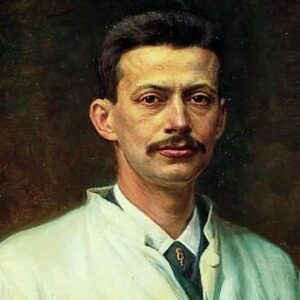Ryberg, Niels Finsen was a Faroese-Icelandic physician and scientist who is most known for inventing modern phototherapy. He was given the Nobel Prize in Medicine and Physiology for his contribution to the use of focused light radiation to treat skin illnesses such as lupus vulgaris. Finsen discovered that exposing smallpox patients to red light, which is created by eliminating the violet end of the spectrum, prevents the development of smallpox pockmarks. Finsen knew that sunlight kills bacteria, thus he devised a successful UV treatment for tuberculosis of the skin. Newer means of treatment, such as drug therapy and radiation, have emerged in the twenty-first century, but the discovery of phototherapy remains a cornerstone of radiation therapy in bacteriological research. Finsen has Pick’s disease, which thickens the connective tissue of the liver, heart, and spleen membranes, since he was a child. He was confined to a wheelchair due to his condition and was unable to attend the Nobel Prize ceremony in Stockholm. During the later years of his life, he tried a variety of methods to combat the symptoms of his condition, including eating a low-salt diet. Despite his terrible health, he was an intellectually sharp man who did not allow his troubles to get in the way of his scientific work.
Childhood and Adolescence
Niels Ryberg Finsen was born in Thorshavn, Faroe Islands, on December 15, 1860. He was the second oldest of Hannes Steingrim Finsen and Johanne Fröman’s four children.
When his father accepted a job as a Landfoged (Faroe Islands revenue collector) in 1858, his family migrated from Iceland to Tórshavn. He was appointed ‘amtmand’ of the islands in 1871.
Finsen’s widowed father married his mother’s cousin Birgitte Kirstine Formann when he was four years old, and they had six children.
Finsen had his early schooling in Tórshavn schools, but in 1874 he entered at Herlufsholm, a Danish boarding school where his older brother Olaf also studied.
Finsen’s grades at Herlufsholm were poor when he was young. Niels was described by his rector as “a youngster with a nice heart but limited abilities and energy.”
In 1876, he was sent to his father’s former school, Lri skólinn, in Reykjavk, where his grades improved dramatically despite his lack of knowledge of the language.
Finsen enrolled in the University of Copenhagen’s medical school in 1882 and graduated in 1890. He went on to work at the university as a prosector of anatomy after graduation.
In 1893, he resigned from his position as prosector to focus solely on his scientific study.
Career of Niels Ryberg Finsen
In order to make ends meet, Finsen used to train medical students.
He became a professor at the University of Copenhagen in 1898. His health began to deteriorate from this point on.
His illness, on the other hand, motivated him to sunbathe and so played a significant part in his studies.
He began collecting data on animals that sought the light and came to the conclusion that the sun had a beneficial influence on the blood.
In 1893, he developed a red light cure for smallpox. In the same year, he published his findings in the book ‘Om Lysets Indvirkninger paa Huden’ (On the Effects of Light on the Skin).
He created a method for treating lupus vulgaris in 1895 by advancing the same technology, namely the concentration of chemical rays free of heat rays.
He founded the Finsen Institute in Copenhagen in 1896. Following the sponsorship of two Danish donors, Mr. Hageman and Mr. Jörgensen, as well as the Danish government, the institute was later enlarged.
He authored a classic treatise in 1896.12
‘En Ophobning af Salt I Organismen’ (An Accumulation of Salt in the Organism), published in 1904, was a study of his ailment and how he dealt with it.
He was knighted in 1899 and was given the title of Knight of the Order of Dannebrog, to which the Silver Cross was added after a few years.
Major Projects of Niels Ryberg Finsen
Ryberg, Niels Finsen’s idea of phototherapy, which indicates that exposure to daylight or specific wavelengths of light can treat skin illnesses such as smallpox and neonatal jaundice, was his breakthrough study. Finsen’s Therapy, a novel carbon arc treatment for lupus vulgaris, won him fame. Finsen demonstrated that refractive rays from the sun or an electric arc can have a beneficial effect on damaged skin tissues through simple tests.
Achievements & Awards
For his work on phototherapy, Niels Ryberg Finsen was awarded the Nobel Prize in Physiology in 1903. He gave 50,000 crowns of the Prize to his Light Institute and another 60,000 crowns to a hospital he had created to treat heart and liver problems. He was the first Scandinavian to win the Nobel Peace Prize, and he remains the sole Faroese Nobel Laureate.
Many societies in Scandinavia, Iceland, Russia, and Germany honored him as an honorary member.
For his achievements, he was awarded a Danish gold medal. The Cameron Prize was granted to him by Edinburgh University in 1904.
Personal History and Legacy
Finsen married Ingeborg Balslev, the daughter of bishop Balslev, on December 29, 1892 in Ribe.
The couple had four children, the eldest of whom passed away. Halldor, his second son, was a physician, and Gudrun, his eldest daughter, was married to Professor S. Lomholt, the head of the Finsen Institute’s Department of Skin Diseases.
Finsen was restricted to a wheelchair due to his heart problems, as well as his overall frailty and ascites.
Niels Ryberg Finsen died in Copenhagen on September 24, 1904.
The Finsen Laboratory, the Finsensvej in Frederiskberg, and the Finsen Power Station are among the places named after him.
A memorial by Rudolph Tegner by the name of ‘Mod lyset’ (Towards the Light) was installed in Copenhagen in 1909 in the honour of Fensen’s discovery of the therapeutic effects of sunlight.
Estimated net worth
The estimated net worth of Niels Ryberg Finsen is unknown.


